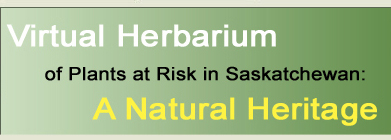|
| Doellingeria
umbellata var. pubens (Gray) Britt. |
|
| |
| TAXONOMY |
| |
| Family: |
Asteraceae or Compositae |
| Genus: |
Doellingeria |
| |
| Species Synonyms: |
Aster pubentior Cronq.
Doellingeria
umbellata ssp. pubens (Gray) A. & D. Löve
Aster
umbellatus var. pubens Gray |
| Common Names: |
flat-topped aster
parasol whitetop
umbellate aster |
| |
| DISTRIBUTION |
| |
| Canada: |
Alberta, east-central – southeastern Saskatchewan
– New Brunswick |
| Saskatchewan: |
east-central – southeastern Saskatchewan;
Nitenai River Salt Marsh – Duck Mountain, Runnymede, Spy Hill |
| Ecoregion: |
Aspen Parkland, Boreal Transition, Mid-Boreal
Lowland |
| |
| HABITAT |
| |
| Saskatchewan: |
moist, open woods and clearings, wooded bogs,
and marsh edges |
| Associated Species: |
Canada thistle, dwarf red raspberry, giant goldenrod,
Labrador tea, purple meadow rue, purple-stemmed aster, red osier dogwood,
stinging nettle, tamarack, white panicle aster |
| |
| RARITY STATUS |
| |
Provincial
Status According
to Harms (2003): |
Vulnerable |
| Nature Conservancy
Status: |
G5 S3 |
Saskatchewan
Species at
Risk Status: |
None |
| COSEWIC Status:
|
None |
| |
| Flat-topped aster
is vulnerable because it is uncommon in Saskatchewan and is somewhat regionally
restricted. Most local populations are small and are threatened by habitat
loss. |
| |
| SPECIES
DESCRIPTION |
| |
| Height: |
50 – 200 cm tall |
| Roots: |
rhizome well-developed |
| Stems: |
perennial, very leafy, round,
minutely hairy |
| Leaves: |
basal and lower stem leaves
alternate, subsessile, 4 – 12 cm long, 1 – 2 cm wide, slightly
reduced upwards, ellipse-shaped, tip tapered, hairless to rough hairy above,
minutely hairy below, thin and soft, margin entire |
| Inflorescence: |
heads several in a flat-topped
cluster, 12 – 20 mm across; stalk and bracts not glandular; bracts
in 2 – 3 series, 3 – 5 mm tall, overlapping, thin, dry and membranous,
straw-coloured midvein, may be minutely hairy, spine absent |
| Flowers: |
ray and disc florets; ray flowers
5 – 10, 5 – 8 mm long, white; disc flowers yellowish |
| Fruits: |
achenes ~ 2 mm long, hairy;
pappus in 2 series, inner series of firm whitish bristles, outer series
of short, whitish hairs |
| |
| ASTER
COMPLEX KEY FOR SPECIES FOUND IN SASKATCHEWAN |
| |
| 1 Basal and lower stem leaves heart-shaped
and stalked |
Symphyotrichum ciliatum |
| 1 Basal and lower stem leaves tapering
at base, sessile to subsessile |
2 |
| |
|
| 2 Rays inconspicuous or absent |
Symphyotrichum ciliatum (A.
brachyactis) |
| 2 Rays conspicuous |
3 |
| |
| 3 Bracts glandular, sometimes also
otherwise hairy |
4 |
| 3 Bracts not glandular, but may be
hairy |
7 |
| |
|
| 4 Leaves toothed |
Eurybia conspicua |
| 4 Leaves entire or nearly so, margins
at most with sharp, straight hairs |
5 |
| |
|
| 5 Stem leaves linear; sessile (lower
ones stalked) |
Almutaster pauciflorus |
| 5 Stem leaves lance-shaped all sessile
to clasping |
6 |
| |
|
| 6 Inflorescence stalks short; inflorescence
compact |
Symphyotrichum novae-angliae |
| 6 Inflorescence stalks elongate; inflorescence
loose |
Canadanthus modestus |
| |
| 7 Pappus double |
Doellingeria umbellata (var. pubens
if leaf puberulent underneath) |
| 7 Pappus single |
8 |
| |
|
| 8 Bracts with spiny tips |
9 |
| 8 Bracts without spiny tips |
10 |
| |
|
| 9 Heads small; bracts 2 – 5
mm high, overlapping; rays 10 – 20 |
Symphyotrichum ericoides var. ericoides |
| 9 Heads larger; bracts 5 – 8
mm high, bracts not strongly overlapping; rays 22 - 35 |
Symphyotrichum falcatum var. falcatum |
| |
|
| 10 Leaves firm; bracts hard or firm,
thickened at base, green-tipped |
11 |
| 10 Leaves thin and soft; bracts thin
and scarious, not markedly thickened at base |
12 |
| |
|
| 11 Plants < 50 cm tall; leaves
linear to narrowly oblong, entire |
Oligoneuron album |
| 11 Plants 40 – 100 cm tall;
leaves oval to lance-shaped |
Symphyotrichum laeve var. laeve |
| |
|
| 12 Stem leaves strongly clasping at
base |
Symphyotrichum puniceum var.
puniceum |
| 12 Stem leaves sessile, scarcely clasping
to not at all clasping with ear-like lobes (if half clasping, not abruptly
contracted to a winged petiole) |
13 |
| |
| 13 Rays white |
Symphyotrichum lanceolatumvar.
lanceolatum |
| 13 Rays purple or pink, rarely white |
14 |
| |
|
| 14 Bracts subequal |
Symphyotrichum eatonii |
| 14 Bracts unequal |
15 |
| |
|
| 15 Stems stout, to > 2 m tall;
leaves lance-shaped to broadest at the middle |
Symphyotrichum prenanthoides |
| 15 Stems slender, < 1 m tall; leaves
linear to lance-shaped |
16 |
| |
|
| 16 Leaves firm; bracts pointing downward |
Symphyotrichum adscendens |
| 16 Leaves relatively thin; bracts
not pointing downward |
17 |
| |
|
| 17 Leaves mostly 2 – 5 mm wide;
heads few (<10) |
Symphyotrichum boreale |
| 17 Leaves wider; heads > 10 |
Symphyotrichum lanceolatum var.
hesperium |
|






